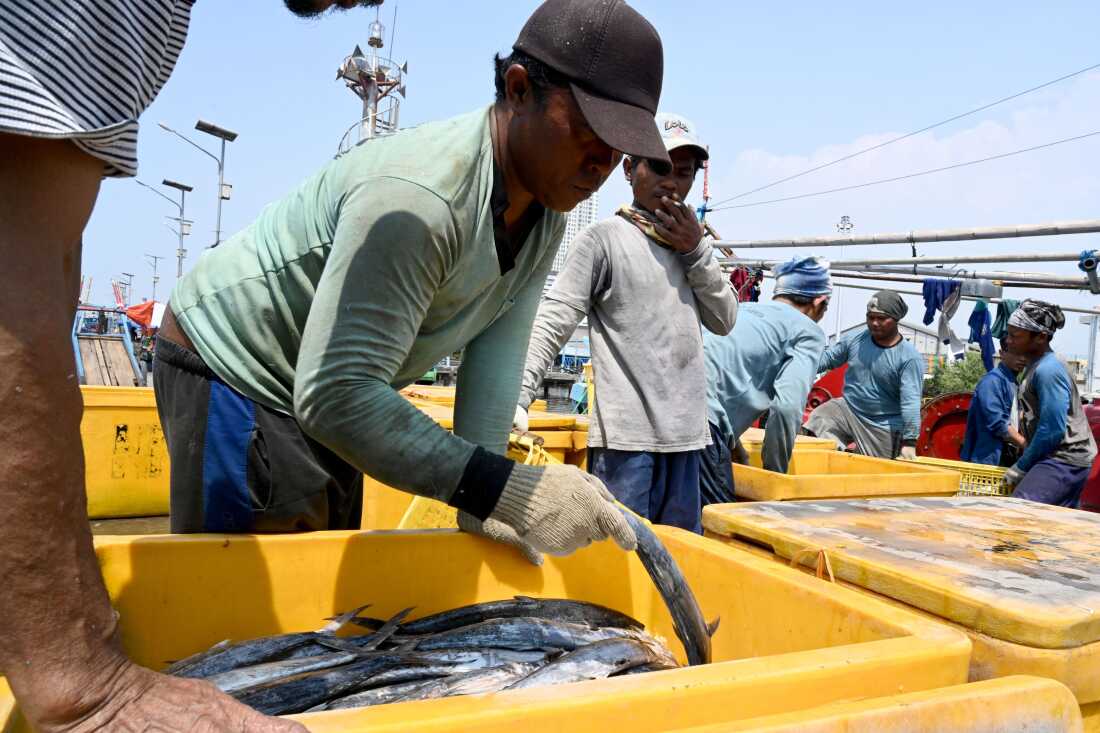
Indonesian fishermen unleashes their catches at the port of Jakarta on May 5, 2019.
Goh Chai Hin / AFP via Getty Images
hide
tilting legend
Goh Chai Hin / AFP via Getty Images
A trip to the grocery store or the alcohol store is about to become even more expensive, according to economists, following the last cycle of import rates announced by President Trump on Wednesday. These prices – taxes paid by companies on foreigners – Come in the heels of a previous round aiming specifically Canada, Mexico and China.

The prices of items such as seafood, coffee, wine, nuts and cheese should all increase. And if you are tempted to take a candy bar while you are in the cash line, you will probably have to pay more for that.
The analyst of the food industry Phil Lepert, also editor -in -chief of Supermarketguru.com, believes that with the latest prices added to import taxes already imposed on grocery products in China, Canada and Mexico, “probably almost half of the products in a supermarket – around 40,000 products.”
Joseph Balagtas, professor of agricultural economics at Purdue University, says that food prices will also be affected by other factories related to prices, such as higher costs for Canada fertilizers and a lower US dollar.
“A main point to remember here is that the prices specific to the country and specific to food will not tell the whole story,” he said. “This is a great change in policy that there will be wider implications.”
It is still impossible to know how much prices will affect prices, but with the price of 10% for many countries and higher “reciprocal prices” on other nations, prices per country could provide indices.
Here are 10 grocery articles on which you may want to keep an eye and their country of origin (with rate rates in parentheses).
Sea fruit
Higher sources: Canada (25%), Chile (10%), India (26%), Indonesia (32%) and Vietnam (46%) are the largest suppliers, according to the US Department of Agriculture.

This category is likely to take a big blow because the United States imports the vast majority of its seafood – up to 85% according to the National Oceanic and Atmospheric Administration – and several countries which provide fish and crustaceans in the United States have been among the hardest by prices.
Coffee
Higher sources: Brazil (10%) and Colombia (10%), according to the USDA.

The United States is the largest coffee importer in the world, with around 80% of us, roasted imports from Latin America. More than 60% come from only two countries – Brazil and Colombia, says the USDA.
Fruit
Higher sources: Mexico (25%), Canada (25%), Guatemala (10%), Costa Rica (10%) and Peru (10%)
Mexico provides 60% of American fruits, such as lawyers, strawberries, raspberries, blackberries and blueberries, according to Lepert. But Guatemala and Costa Rica also lead banana exporters to the United States, Guatemala also ships melons, plantains and papaya, according to USDA, while Costa Rica exports pineapple, lawyers and mangoes.
“These products do not have a long shelf life, and with the prices, we will face important problems with the price and availability,” explains Lepert.
Alcohol
Higher sources of wine: the European Union – France, Italy and Spain (20%). New Zealand (10%) and Australia (10%), according to the USDA.
Top sources for Bire: Mexico City (25%), the Netherlands and Ireland (both with the 20%price of the EU) and Canada (25%)

If your favorite summer drink is Modelo, Corona, Heineken or Guinness, you will probably pay more. Tequila imports from Mexico have also experienced a wave in recent years and will be affected by prices.
Lepert says that the imported alcohol sector is probably “to take away”. He also notes that beer sold in cans will also get a double blow due to prices on China and other aluminum producers.

Mexico tequila bottles are exhibited on a shelf in a Safeway store in San Anselmo, California, March 3.
Justin Sullivan / Getty images
hide
tilting legend
Justin Sullivan / Getty images
Beef
According to USDA, the main sources: Canada (25%), Mexico (25%), New Zealand (10%) and Australia (10%).
Although 90% of the beef consumed in the United States is produced at the national level, prices will probably increase to the pressure of existing prices. The cost of chopped beef for consumers, for example, is already at historical summits and according to the USDA, the herd of American cattle has been the smallest since 1951.
Rice
According to the USDA (36%) and India (26%) (36%) and India (26%).
Although most rice sold in the United States is produced at the national level, almost a third is imported, mainly Jasmine rice from Thailand and basmati rice from India.
Cheese
According to USDA, the best sources: Italy, France, Spain and the Netherlands (all subject to 20% EU rate).
AmongGian-Reggiano, Brie and Gouda could also see price increases.
Nut
According to the World Bank, the best sources: Vietnam (46%), Côte d’Ivoire (21%), Brazil (10%), Thailand (36%).
Cabjales, Pacans and Macadamia nuts are likely to see the most important price increases.

A farmer holds cocoa beans on a farm in the village of Offoumpo, near Agboville, Côte d’Ivoire in West Africa on April 7, 2024.
Issouf Sanogo / AFP via Getty Images
hide
tilting legend
Issouf Sanogo / AFP via Getty Images
Chocolate
Top Source: Ivory Coast (21%) and Ecuador (10%), according to the USDA.
The Hershey Company, one of the largest American importers of cocoa beans, says that he gets to get in Brazil, Cameroon, Côte d’Ivoire, Colombia, Dominican Republic, Ecuador, Ghana, Indonesia, Nigeria, Papua New Guinea and Peru.
NPR has contacted Hershey, which makes cups of peanut butter from Reece and Kit Kat bars, among others, to find out about future price increases. A spokesperson for Hershey, Todd Scott, said that the company could not comment because it is in a income window.
However, Lepert says that the prices have come in addition to “serious increases in cocoa beans for the past two or three years due to the weather and the political climate in … Africa.”
Olive oil
Higher sources: European Union (20%), in particular Spain, Italy and Greece.
“The prices of olive oil have crossed the roof,” explains Lepert. “They will go even higher.”


